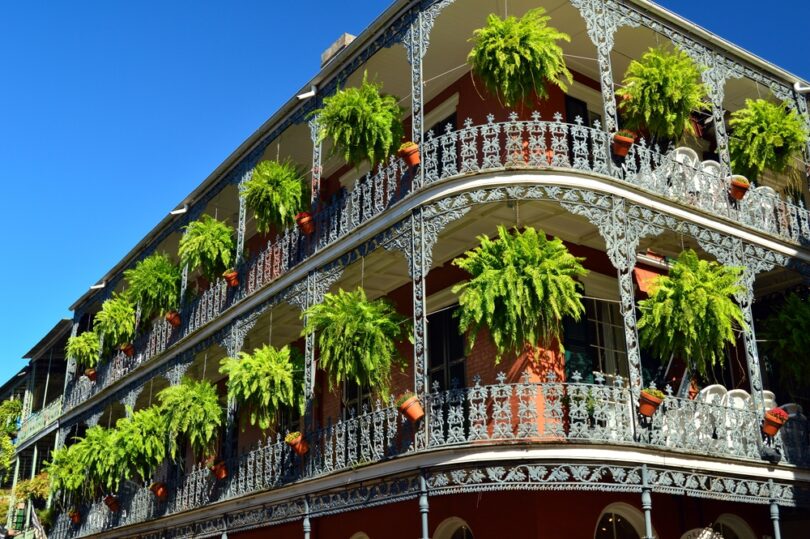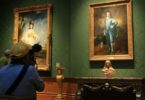Wander through the French Quarter in New Orleans and you’ll be amazed by the houses you’ll see there, from Greek revival mansions to colorful Creole cottages. The French Quarter, also known as Vieux Carré, dates back to 1718 when the city was founded by French colonists, making it the oldest neighborhood in New Orleans.
Over the centuries, New Orleans architecture has been shaped by French, Spanish, and American influences, creating a distinctive blend of architectural styles that tell the story of its rich and turbulent history. From surviving devastating fires in the late 18th century to thriving as a vibrant cultural hub today, New Orleans reflects the city’s resilience and creativity.
Here are some of the finest houses you can see in the French Quarter and beyond.
The LaBranche House
Even if you have never been to New Orleans, you have probably seen photographs of the LaBranche House. Built in 1835, this striking residence on Royal Street is easily the most photographed building in the French Quarter, thanks to its signature lacy cast-iron balconies. The intricate grillwork, with motifs of oak leaves and acorns, reflects the high craftsmanship of 19th-century Creole artisans. These balconies, which wrap around all three floors of the building, were designed not only for decoration but also to provide shade and cooling in the sweltering Louisiana heat.
The house itself exemplifies the Creole townhouse style, with its symmetrical façade, tall windows, and colorful stucco exterior. The structure was commissioned by Jean Baptiste LaBranche, a wealthy sugar planter, during a period when New Orleans was flourishing as a cultural and economic hub. Today, the LaBranche House is a reminder of the city’s prosperous past and its architectural heritage.
Rillieux-Waldhorn House

Image via Flickr – CC BY-SA 2.0 – Ken Lund
For those captivated by New Orleans’ iconic wrought-iron balconies, the Rillieux-Waldhorn House on Royal Street offers yet another example. Built between 1795 and 1800, this home showcases the Spanish colonial influence that shaped much of the French Quarter’s architecture during Spain’s control of Louisiana. The ironwork adorning the balconies reflects the skilled craftsmanship of the era, blending functional design with intricate detail.
The house was constructed for Dominique Rillieux, a prominent free man of color and the great-grandfather of French Impressionist painter Edgar Degas. This historical connection adds an artistic dimension to the house’s significance. Its enduring elegance, marked by the colonial-style balconies and stucco façade, highlights the multicultural legacy of New Orleans. As you admire the building’s graceful proportions and meticulous design, you’re stepping into a chapter of history that shaped the city’s architectural character.
Gallier House

Gallier House by Infrogmation licensed under CC BY-SA 4.0
Gallier House, located at 1132 Royal Street, offers a glimpse into the opulence of mid-19th-century New Orleans. Designed and built in 1857 by James Gallier Jr., one of the city’s most celebrated architects, the house reflects the height of Victorian design and innovation. The structure showcases Gallier’s architectural prowess, with its symmetrical façade, intricate ironwork, and grand interiors that epitomize pre-Civil War elegance.
Inside, visitors can explore lavishly furnished rooms that paint a vivid picture of life during New Orleans’ golden age. The home also features a detailed garden, an authentic carriageway, and restored slave quarters, offering a comprehensive view of the societal dynamics of the era. Gallier’s attention to both form and function is evident throughout, making this house a masterclass in period architecture. Today, the meticulously preserved Gallier House serves as a museum, allowing guests to step back in time and experience the grandeur of 19th-century New Orleans firsthand.
Madame John’s Legacy

Image via Flickr – CC BY-SA 2.0 – Teemu008
Madame John’s Legacy, located at 632 Dumaine Street, is one of the finest surviving examples of 18th-century French colonial architecture in the French Quarter. Built in 1788, shortly after a devastating fire swept through New Orleans, the house reflects the resilience of the city’s early residents. Unlike many of the brick-and-stucco structures that dominate the neighborhood, this building is constructed primarily of wood, showcasing the raised Creole cottage style that was common during the period.
The house’s name derives from a character in a short story by 19th-century author George Washington Cable. With its steeply pitched dormered roof and wide veranda, Madame John’s Legacy captures the practicality and beauty of early Louisiana design, offering cooling shade and protection from flooding. Visitors are drawn to its understated elegance and the opportunity to experience an architectural style that predates much of the French Quarter’s later developments. As one of the few buildings to survive both fires and centuries of urban evolution, it serves as a rare portal to the city’s colonial past.
Hermann-Grima House

Image via Flickr – CC BY 2.0 – Reading Tom
The Hermann-Grima House, located at 820 St. Louis Street, is a quintessential example of early American architecture in the French Quarter. Built in 1831, this Federal-style mansion reflects the aspirations of New Orleans’ wealthy Creole families during the city’s golden age. Its stately brick façade, symmetrical design, and refined interiors evoke an air of sophistication that contrasts with the more flamboyant Creole townhouses nearby.
Inside, the home provides a vivid portrayal of 19th-century life, complete with restored parlors, bedrooms, and dining areas that showcase period furnishings and décor. Beyond its elegant interiors, the Hermann-Grima House features a beautifully preserved courtyard garden, a rarity in urban settings, as well as original outbuildings like a horse stable and one of the city’s earliest outdoor kitchens. These details highlight the blending of European traditions with local adaptations for New Orleans’ subtropical climate. Today, the house serves as a museum, offering a window into the lives of the upper-class families who once inhabited the French Quarter.
Lalaurie Mansion

Lalaurie Mansion
The Lalaurie Mansion, located at 1140 Royal Street, is one of the most infamous and architecturally significant houses in the French Quarter. Built in 1832 for Delphine Lalaurie, a prominent New Orleans socialite, the mansion reflects the grandeur of Creole townhouses of the period, with its stately façade, elegant wrought-iron balconies, and large windows designed to invite breezes from the Mississippi River.
Despite its architectural beauty, the mansion is best known for its dark history. Stories of cruelty and tragedy during Lalaurie’s ownership have cemented its place in local legend, making it a prominent stop on ghost tours and historical walks through the French Quarter. The house’s haunting past has added to its mystique, attracting visitors fascinated by its blend of elegance and eeriness. While privately owned and not open to the public, the Lalaurie Mansion remains an iconic landmark in the French Quarter. Its enduring presence offers a reminder of the city’s layered history.
Colonel Short’s Villa

Colonel Short’s Villa by Elisa.rolle licensed under CC BY-SA 3.0
Colonel Short’s Villa, located at 1448 Fourth Street in the Garden District, is a masterpiece of Italianate architecture, often admired for its striking cast-iron galleries and lush surroundings. Built in 1859 by Henry S. Buckner and later purchased by Colonel Robert H. Short, the villa features intricate ironwork with a distinctive corn stalk motif — a nod to Short’s wife’s Kentucky heritage and their agricultural ties.
The home’s design reflects the wealth and taste of pre-Civil War New Orleans, with its symmetrical layout, tall windows, and grand entrance framed by Corinthian columns. The villa’s gardens, meticulously landscaped with native flora, add to its elegance and appeal. Colonel Short’s Villa remains a private residence, but its exterior draws countless visitors who marvel at the craftsmanship and historical significance. Its distinctive style and connection to New Orleans’ antebellum history make it a highlight for architecture enthusiasts exploring the city’s storied streets.
Pontalba Buildings

Pontalba Buildings
The Pontalba Buildings, flanking Jackson Square, are among the oldest apartment buildings in the United States and a cornerstone of New Orleans’ architectural heritage. Commissioned in the 1840s by Baroness Micaela Almonester de Pontalba, a wealthy and influential Creole heiress, the buildings exemplify the elegance and practicality of mid-19th-century French Quarter design.
Constructed with distinctive red brick exteriors and adorned with ornate cast-iron balconies, the Pontalba Buildings seamlessly blend form and function. Their intricate ironwork includes the baroness’s initials, “A.P.,” a personal touch that highlights her involvement in the project. Originally intended to provide modern accommodations for the time, the buildings helped to transform Jackson Square into the cultural and civic heart of New Orleans. Today, the Pontalba Buildings house shops, galleries, and apartments, remaining hubs of activity.
FAQs:
Q: What is the best time of year to visit the French Quarter for sightseeing?
A: The best time to visit is in the spring (March to May) or fall (September to November) when the weather is mild, and the city hosts numerous festivals. Avoid the summer heat and humidity if possible.
Q: Are the houses mentioned open to the public?
A: Some houses, like Gallier House and Hermann-Grima House, are museums and open for tours. Others, such as the Lalaurie Mansion, are private residences and can only be admired from the outside.
Q: How long does it take to explore the French Quarter?
A: Plan to spend at least a full day exploring the French Quarter, but architecture enthusiasts may want to dedicate more time to fully appreciate its historic buildings and details.
Q: Are guided tours available to learn more about French Quarter houses?
A: Yes, many companies offer guided walking tours focusing on the French Quarter’s architecture and history. Some tours even include access to interiors of select buildings.
Q: Is the French Quarter accessible for visitors with mobility concerns?
A: While many streets are walkable, the uneven sidewalks and cobblestones may be challenging. Some museums and attractions offer accessibility options—check ahead to confirm details.
Q: Are there good dining options near the historic houses?
A: The French Quarter is full of excellent restaurants and cafes. For local flavors, try classic Creole cuisine at nearby establishments like Café Amelie or Court of Two Sisters.
Q: Where can I park if I’m driving to the French Quarter?
A: Parking is limited in the French Quarter, so consider using public parking garages like the Jax Brewery Parking Lot or Premium Parking P915. Street parking can be challenging to find.










Very helpful. My wife is a food tour guide in New Orleans, now segueing into combined history tours, and these tidbits give her extra stuff to talk about.